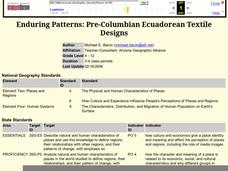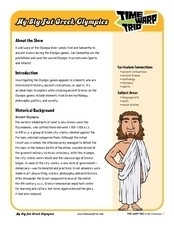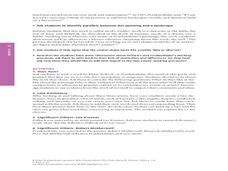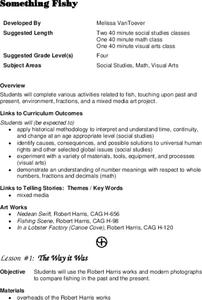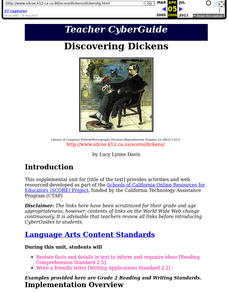Curated OER
Rise of the Modern City
Students investigate the industrial developments of the twentieth century and the development of urban environments. In this industrial art instructional activity, students compare and contrast graphics and analyze industrial...
Curated OER
Enduring Patterns: Pre-Columbian Ecuadorean Textile Designs
Young scholars examine Pre-Columbian Ecuadorean design motifs. They view examples of the designs, discuss the motif themes, and replicate the designs on modern fabric using authentic methods.
Curated OER
Cooking in Britain Today
Learners explore British cooking vocabulary. In this ELL vocabulary lesson, students identify and describe various foods, match foods with adjectives, discuss their opinions about British cuisine, then read food critic reviews. Four...
Hawaiʻi State Department of Education
Angles on Kandinsky
Not only is Wassily Kandinsky fun to say, his art contains tons of angles. Learners discuss Kandinsky's music-inspired abstract art and four types of angles. They search one of his paintings for obtuse, right, straight, and acute angles,...
Time Warp Trio
My Big Fat Greek Olympics
The Olympic Games are indeed a significant and far-reaching cultural component in our international community today, but from where do they originate? Where do our traditions stem from, and how do we choose the sports that constitute...
Curated OER
Nureyev: Bringer of Light
Students examine Nureyev's artistic endeavors and achievements. In this language and art activity, students analyze modes of dance expression at the end of the 19th - beginning of the 20th centuries. They focus on Martha Graham and...
DiscoverE
Build a Bobsled Racer
Host a design challenge of Olympic proportion! Junior engineers build their own bobsleds using simple materials. The activity focuses on kinetic and potential energy and how the center of mass affects motion on a downhill track....
Curated OER
Revolutions in Painting
Students analyze Abstract Expressionist artists and their art. In this art analysis instructional activity, students view the works by Jackson Pollock and Helen Frankenthaler and analyze the pieces. Students complete image based...
Curated OER
Something Fishy
Fourth graders study the Robert Harris works and modern photographs. They compare fishing in the past and the present. They use their knowledge of equivalent fractions to play a version of the game "Go Fish".
Curated OER
Dry-Land Kalo-Growing New Plants from Stems
Students explore Hawaiian plants. In this Hawaii culture and botany lesson, students plant the haha(stem) of a taro plant. Students listen to Hawaiian myths about the taro plant and chorally speak a Hawaiian chant of protection. Students...
Curated OER
Check the Mates
Students explore John Edwards, the running mate for 2004 Democratic presidential candidate John Kerry. They research the ways in which vice presidential candidates have impacted presidential elections in modern United States history.
Curated OER
Discovering Dickens
Students restate facts and details in text to inform and organize ideas and have a choice of four activities to enhance learning,
Curated OER
A Conventional Family
Students explore writing techniques by analyzing their own families. In this family values instructional activity, students view the film "The Incredibles" in class and discuss the different types of modern-day families. Students write...
Curated OER
Modern Day Characters from Children's Literature
Students read several studenT fairy tales, nursery rhymes, or folk tales. They compare themes and narratives in each version. They rewrite a story that they have read, placing the characters in a contemporary setting and include...
Curated OER
The Bard: Shakespeare Up Close
Students choose a Shakespearean play to reenact into a modern setting. In this Shakespeare instructional activity, students practice insulting each other using Shakespearean language. Students watch Shakespeare plays and complete online...
Curated OER
Fairy Tales
Learners write and draw fairy tales based on modern themes and/or their own experiences. The class is divided into groups and are assigned a fairy tale. The groups develop a modern story based on this fairy tale through group discussion.
Curated OER
Chairs, Rooms, and Time Travel
Students compare and contrast two chairs that were made in different time periods. In this compare and contrast lesson students will compare two chairs They will then create a collage that takes place in a historic scene inspired by...
Curated OER
The Scarlet Letter
Students design a model that replicates a scene from The Scarlet Letter. They design four greeting cards for the main characters to send to each other. Students create a poster that compares Hawthorne's scarlet letter to a modern scarlet...
Curated OER
Analyzing Election Cartoons
Students are introduced to the history of political cartoons and examine both historical and modern examples. They analyze a cartoon that expresses an opinion about a current event different than their own and develop an original cartoon...
Curated OER
Depicting Women and Class in a Global Society
Students analyze the evolution of women's work from the 19th century to present day and create artwork depicting women. In this women's roles lesson, students compare and contrast the use of space and color in the two paintings depicting...
Curated OER
Plodding Along: The Dan Wagoner Experiment
Students research Dan Wagoner and apply his choreographic ideas in "Plod" to dance study. In this art lesson, students discuss Dan Wagoner. Students select four shapes from "Plod" and connect in a dance.
Curated OER
A Changing Society
Seventh graders examine Chaucer's work about the medieval times. In groups, 7th graders imagine what modern activities could replace some tasks used in medieval times.
Curated OER
Land of the Rising Sun
Students survey aspects of traditional and modern Japanese customs and beliefs in the seven lessons of this unit. Both the culture and the geography of the country are studied in this unit.
Curated OER
AT YOUR FINGERTIPS
The student will locate countries on a world map from which we import foods that our climate prevents us from growing locally.1. Discuss the term "export." Divide students into groups of four. Give the groups
five minutes to brainstorm...

